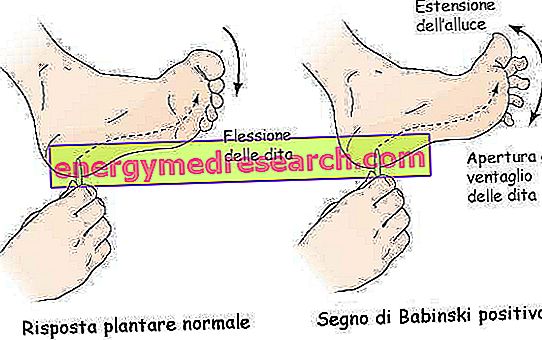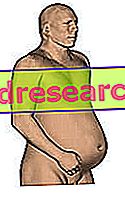
The Babinski sign is an abnormal motor response, evoked by mechanical stimulation of the lateral margin of the sole of the foot; in particular, by swiping in this area a blunt point (for example, scratching it with a pencil or a wooden rod), starting from above the heel to the base of the big toe, in normal conditions, the fingers are flexed. If this reflex, called plantar skin reflex, is reversed (that is, if the fingers extend rather than flex, opening up like a fan), we speak of a Babinski sign. Summarizing with the help of the figure:
- a flexion (downwards) of the fingers and the sole of the foot is recorded under normal conditions (negative Babinski sign);
- an extension (upwards) of the big toe and a fan-shaped enlargement of the other fingers (Dupré fan) are recorded in abnormal conditions (positive Babinski sign).
A positive sign of Babinski is not uncommon, even in absolutely normal conditions, up to 2-3 years of life, as the development of the central nervous system is still incomplete at this stage. In the later stages of life, however, a positive sign of Babinski is a sign of damage at the level of the corticospinal bundle (which provides for the voluntary fine movements of the muscles and which, in physiological conditions, exerts a tonic reflex bite).
The Babinski sign can therefore be seen in the case of corticospinal (or pyramidal) lesions, while it is absent in extrapyramidal lesions; it can appear for example in patients with amyotrophic lateral sclerosis and in the terminal phases of diseases such as rabies, hepatic encephalopathy and metachromatic leukodystrophy.
An analogous answer to the Babinski sign can be obtained with the sign of Oppenheim (crawling along the tibial crest the thumb and the index, from the knee towards the foot), with the sign of Gordon (compression of the calf with the palm of the hand), with the sign of Chaddock (creeping with a blunt tip under the outer malleolus and the lateral edge of the back of the foot, from back to front) and with the sign of Schaefer (energetic compression of the Achilles tendon between the index and the thumb ). These "alternative" maneuvers are suitable for those patients who do not tolerate the stimulation of the sole of the foot and respond with sudden "annoying" movements. Furthermore, the negativity of these additional signs significantly reduces the meaning of a positive Babinski sign.



